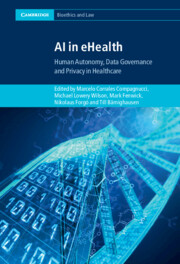Refine search
Actions for selected content:
7351 results for ai文章生成器官网,专门看ai的网站,国家电网ai大模型,斑马ai网址,ai画图模型网站,等欢迎访问豌豆Ai站群搜索引擎系统官方网站:www.wd.chat
The AI in AI EDAM
-
- Article
-
- You have access
- HTML
- Export citation
AY
-
- Book:
- A History of Egypt
- Published online:
- 05 March 2014
- Print publication:
- 03 October 2013, pp 238-242
-
- Chapter
- Export citation
10 - AI Ethics and Ethical AI
- from Part II - Social and Moral Issues
-
-
- Book:
- The Cambridge Companion to Religion and Artificial Intelligence
- Published online:
- 20 November 2024
- Print publication:
- 21 November 2024, pp 165-181
-
- Chapter
- Export citation
The feminine endings *-ay and *-āy in Semitic and Berber
-
- Journal:
- Bulletin of the School of Oriental and African Studies / Volume 81 / Issue 2 / June 2018
- Published online by Cambridge University Press:
- 28 March 2018, pp. 205-225
- Print publication:
- June 2018
-
- Article
- Export citation
1 - Generative AI
- from Part I - Understanding Generative AI from Multidisciplinary Perspectives
-
-
- Book:
- The Cambridge Handbook of Generative AI and the Law
- Published online:
- 08 August 2025
- Print publication:
- 07 August 2025, pp 3-10
-
- Chapter
- Export citation

AI in eHealth
- Human Autonomy, Data Governance and Privacy in Healthcare
-
- Published online:
- 08 September 2022
- Print publication:
- 15 September 2022
2.6 - AI + Law
- from B. - Artificial Intelligence, Machine Learning, Natural Language Processing, and Blockchain
-
-
- Book:
- Legal Informatics
- Published online:
- 04 February 2021
- Print publication:
- 18 February 2021, pp 87-93
-
- Chapter
- Export citation
Quantum AI
-
- Journal:
- Behavioral and Brain Sciences / Volume 13 / Issue 4 / December 1990
- Published online by Cambridge University Press:
- 19 May 2011, pp. 672-673
-
- Article
- Export citation

Governing AI
- A Primer
- Coming soon
-
- Expected online publication date:
- March 2026
- Print publication:
- 31 March 2026
-
- Book
- Export citation

AI and Image
- Critical Perspectives on the Application of Technology on Art and Cultural Heritage
-
- Published online:
- 10 September 2025
- Print publication:
- 09 October 2025
-
- Element
-
- You have access
- Open access
- HTML
- Export citation
Mozart and/as AI
-
- Journal:
- Eighteenth-Century Music / Volume 22 / Issue 1 / March 2025
- Published online by Cambridge University Press:
- 05 March 2025, pp. 67-85
- Print publication:
- March 2025
-
- Article
-
- You have access
- Open access
- HTML
- Export citation
2 - Philosophy of AI
- from Part I - AI, Ethics and Philosophy
-
-
- Book:
- The Cambridge Handbook of the Law, Ethics and Policy of Artificial Intelligence
- Published online:
- 06 February 2025
- Print publication:
- 13 February 2025, pp 40-58
-
- Chapter
-
- You have access
- Open access
- HTML
- Export citation
22 - Medical AI
- from Part VII - Responsible AI Healthcare and Neurotechnology Governance
-
-
- Book:
- The Cambridge Handbook of Responsible Artificial Intelligence
- Published online:
- 28 October 2022
- Print publication:
- 17 November 2022, pp 379-396
-
- Chapter
-
- You have access
- Open access
- HTML
- Export citation
Part VII - Future of AI
-
- Book:
- The Cambridge Handbook of Artificial Intelligence
- Published online:
- 28 July 2022
- Print publication:
- 11 August 2022, pp 345-346
-
- Chapter
- Export citation
Part III - AI and Liability
-
- Book:
- The Cambridge Handbook of Artificial Intelligence
- Published online:
- 28 July 2022
- Print publication:
- 11 August 2022, pp 87-160
-
- Chapter
- Export citation
16 - Patentability of AI
- from Part V - AI and Intellectual Property Law
-
-
- Book:
- The Cambridge Handbook of Artificial Intelligence
- Published online:
- 28 July 2022
- Print publication:
- 11 August 2022, pp 223-239
-
- Chapter
- Export citation
2 - Essence of AI
- from Part I - AI: Development and Trends
-
-
- Book:
- The Cambridge Handbook of Artificial Intelligence
- Published online:
- 28 July 2022
- Print publication:
- 11 August 2022, pp 18-34
-
- Chapter
- Export citation
Appendix H - AI and Python
-
- Book:
- Programming in Parallel with CUDA
- Published online:
- 04 May 2022
- Print publication:
- 02 June 2022, pp 435-437
-
- Chapter
- Export citation
9 - Regulation by AI?
- from Part III - Possibilities
-
- Book:
- We, the Robots?
- Published online:
- 15 July 2021
- Print publication:
- 05 August 2021, pp 224-242
-
- Chapter
- Export citation
8 - Joshua and Ai
-
- Book:
- The Legacy of Israel in Judah's Bible
- Published online:
- 05 August 2012
- Print publication:
- 30 July 2012, pp 133-143
-
- Chapter
- Export citation
